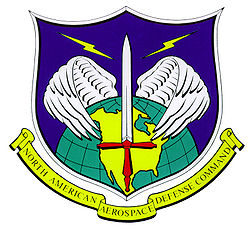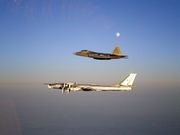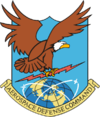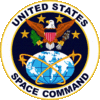North American Aerospace Defense Command
| North American Aerospace Defense Command | |
|---|---|
| Colorado Springs, Colorado, United States | |
 NORAD emblem |
|
| Type | Aerospace warning and aerospace control |
| Coordinates | 38.744331, -104.84668 |
| Built | 1961 (Directorate)[1] |
| In use | 1958 - present |
| Current owner |
Canada / United States |
| Controlled by | Joint operations of Canadian Forces Air Command and United States Air Force and co-location with USNORTHCOM |
| Garrison | Headquarters:Peterson Air Force Base Directorate: Cheyenne Mountain Air Force Station[2] (west of Colorado Springs, CO) |
| Commanders | Admiral James A. Winnefeld, Jr., USN |
| Events | May 2006 NORAD Agreement Renewal |
North American Aerospace Defense Command (NORAD, pronounced /ˈnɒræd/ NORR-ad) is a joint organization of Canada and the United States that provides aerospace warning, air sovereignty, and defense for the two countries.[3] It was founded on May 12, 1958 (an effect of the Cold War) as a joint command between the governments of Canada and the United States, as the North American Air Defense Command. Its main technical facility has been the Cheyenne Mountain Directorate, formerly Cheyenne Mountain Operations Center, of the Cheyenne Mtn. Air Force Station, Colorado; and for this reason NORAD is sometimes referred to as Cheyenne Mountain. In addition, the Canada East and Canada West Sector Air Operations Control Centres are located in the underground complex at Canadian Forces Base (CFB) North Bay in Ontario, Canada.
NORAD's headquarters facilities in Colorado are administered by the U.S. Air Force under the command of the 721st Mission Support Group, part of the 21st Space Wing, headquartered at Peterson Air Force Base. NORAD's forces consist of the Alaskan NORAD Region/Eleventh Air Force, Canadian NORAD Region, and Continental NORAD Region.
Contents |
History
Formation

The growing perception of the threat of long-range Soviet strategic bombers armed with nuclear weapons brought the U.S. and Canada into closer cooperation for air defense. While attacks from the Pacific or Atlantic would have been detected by Airborne Early Warning aircraft, Navy ships, or offshore radar platforms, the Arctic was underprotected. In the early 1950s the U.S. and Canada agreed to construct a series of radar stations across North America to detect a Soviet attack over the Arctic. The first series of radars was the Pinetree Line, completed in 1954 and consisting of 33 stations across southern Canada. However, technical defects in the system led to more radar networks being built. In 1957, the McGill Fence was completed; it consisted of Doppler radar for the detection of low-flying craft. This system was roughly 300 miles (480 km) north of the Pinetree Line along the 55th parallel north. The third joint system was the Distant Early Warning Line (DEW Line), also completed in 1957. This was a network of 58 stations along the 69th parallel north. The systems gave around three hours' warning of a bomber attack before they could reach any major population center.
The command and control of the massive system then became a significant challenge. Discussions and studies of joint systems had been ongoing since the early 1950s and culminated on August 1, 1957, with the announcement by the U.S. and Canada to establish an integrated command, the North American Air Defense Command. On September 12, operations commenced in Colorado. A formal NORAD agreement between the two governments was signed on May 12, 1958.
On June 16, 1961, the official groundbreaking ceremony was held at the construction site of the NORAD Combat Operations Center (COC). Gen. Laurence S. Kuter, NORAD Commander, and Lt. Gen. Robert Merrill Lee, ADC Commander, simultaneously set off symbolic dynamite charges.
Cold War and false alarms

By the early 1960s, about 250,000 personnel were involved in the operation of NORAD. The emergence of the intercontinental ballistic missile (ICBM) and submarine-launched ballistic missile (SLBM) threat in the early 1960s was something of a blow. In response, a space surveillance and missile warning system was constructed to provide worldwide space detection, tracking and identification. The extension of NORAD's mission into space led to a name change, the North American Aerospace Defense Command in March 1981.
From 1963, the size of the U.S. Air Force was reduced, and obsolete sections of the radar system were shut down. However, there was increased effort to protect against an ICBM attack; two underground operations centers were set up, the main one inside Cheyenne Mountain and an alternate at North Bay, Ontario. By the early 1970s, the acceptance of mutual assured destruction doctrine led to a cut in the air defense budget and the repositioning of NORAD's mission to ensuring the integrity of airspace during peacetime. There followed significant reductions in the air defense system until the 1980s, when, following the 1979 Joint US-Canada Air Defense Study (JUSCADS) the need for the modernization of air defenses was accepted—the DEW Line was to be replaced with an improved Arctic radar line called the North Warning System (NWS); there was to be the deployment of Over-the-Horizon Backscatter (OTH-B) radar; the assignment of more advanced fighters to NORAD, and the greater use of Airborne Warning and Control System (AWACS) aircraft from Tinker Air Force Base in Oklahoma or Elmendorf Air Force Base in Alaska. These recommendations were accepted by the governments in 1985. The United States Space Command was formed in September 1985 as an adjunct but not a component of NORAD.
Even though all equipment in Cheyenne Mountain was put through a rigorous inspection, on at least two occasions, failure in its systems could have potentially caused nuclear war. On November 9, 1979, a technician in NORAD loaded a test tape but failed to switch the system status to "test", causing a stream of constant false warnings to spread to two "continuity of government" bunkers as well as command posts worldwide. A similar incident occurred on June 2, 1980, when a computer communications device failure caused warning messages to sporadically flash in U.S. Air Force command posts around the world that a nuclear attack was taking place. Both times, Pacific Air Forces properly had their planes (loaded with nuclear bombs) in the air; Strategic Air Command did not and took criticism because they did not follow procedure, even though the SAC command knew these were almost certainly false alarms (as did PACAF). Both command posts had recently begun receiving and processing direct reports from the various radar, satellite, and other missile attack detection systems, and those direct reports simply didn't match anything about the erroneous data received from NORAD.
Post-Cold War

At the end of the Cold War NORAD reassessed its mission. To avoid cutbacks, from 1989 NORAD operations expanded to cover counter-drug operations, especially the tracking of small aircraft entering and operating within America and Canada[4], thereby contradicting General Richard Myers' statement in his testimony to the 9/11 Commission where he said NORAD was directed "looking outward" on 9/11 (although commercial flights were not perceived to be threats). But the DEW line sites were still replaced, in a scaled-back fashion by the North Warning System radars between 1986 and 1995. The Cheyenne Mountain site was also upgraded. However, none of the proposed OTH-B radars are currently in operation.
Post-September 11, 2001 attacks

After the September 11, 2001 attacks, the NORAD mission evolved to include monitoring of all aircraft flying in the interior of the United States.[5] NORAD oversees Operation Noble Eagle using fighter aircraft Combat Air Patrols (CAP) under command of First Air Force and Airborne Warning and Control System (AWACS) E-3 Sentry aircraft under command of the 552nd Air Control Wing. At U.S. request, NATO deployed five of its NATO AWACS aircraft to the U.S. to help NORAD in the aftermath of the September 11 attacks.
On July 28, 2006, military officials announced that NORAD's day-to-day operations would be consolidated, for purposes of efficiency, in an ordinary building at Peterson Air Force Base in nearby Colorado Springs.[6] The mountain will be kept only as a backup in "warm standby," though fully operational and staffed with support personnel should the need arise. NORAD officials stated that the same surveillance work can be continued without the security the facility provides. They emphasized that they are no longer concerned about a halt to their operations from an intercontinental nuclear attack.
Commanders and deputy commanders
The Commander of NORAD is always American and from 2002 has simultaneously headed USNORTHCOM, while the Deputy Commander is always Canadian. During the course of NORAD's history there have been four different U.S. combatant commands associated with NORAD:
| Name of Command | Abbreviation | Emblem | Association started | Association ended | Type of combatant command | Notes |
|---|---|---|---|---|---|---|
| Continental Air Defense Command | CONAD | September 15, 1957 | June 30, 1975 | joint command 1954-1958 unified command 1958-1975 |
created on September 1, 1954; functions assumed by Aerospace Defense Command | |
| Aerospace Defense Command | ADCOM |  |
July 1, 1975 | December 19, 1986 | specified command | functions assumed by United States Space Command |
| United States Space Command | USSPACECOM |  |
September 23, 1985 | October 1, 2002 | unified command | merged with United States Strategic Command |
| United States Northern Command | USNORTHCOM |  |
October 1, 2002 | continuing | unified command |
Commanders
The NORAD commander is an American four-star General, or equivalent. Since 2004 commanders have included Admirals of the Navy.
| Number | Name | Photo | Start of term | End of term | Notable positions held before or after |
|---|---|---|---|---|---|
| 1 | General Earle E. Partridge, USAF | 1957 | 1959 | ||
| 2 | General Laurence S. Kuter, USAF |  |
1959 | 1962 | |
| 3 | General John K. Gerhart, USAF |  |
1962 | ||
| 4 | General Dean C. Strother, USAF |  |
1965 | 1966 | U.S. Military Representative, NATO Military Committee, 1962–1965 |
| 5 | General Raymond J. Reeves, USAF | 1966 | 1969 | ||
| 6 | General Seth J. McKee, USAF | 1969 | 1973 | ||
| 7 | General Lucius D. Clay, Jr., USAF |  |
1973 | 1975 | |
| 8 | General Daniel James, Jr., USAF |  |
1975 | 1977 | |
| 9 | General James E. Hill, USAF |  |
1977 | 1979 | |
| 10 | General James V. Hartinger, USAF |  |
1980 | 1984 | |
| 11 | General Robert T. Herres, USAF | 1984 | 1987 | 1st Vice Chairman of the Joint Chiefs of Staff (1987–1990) | |
| 12 | General John L. Piotrowski, USAF |  |
1987 | 1990 | 22nd Vice Chief of Staff of the Air Force (1985–1987) |
| 13 | General Donald J. Kutyna, USAF |  |
1990 | 1992 | Member of the Rogers Commission (1986–1988) |
| 14 | General Charles A. "Chuck" Horner, USAF |  |
June, 1992 | September, 1994 | Commander, 9th Air Force, and Commander, U.S. Central Command Air Forces (1987–1992), he led U.S. and allied air operations for Operations Desert Shield and Desert Storm. |
| 15 | General Joseph W. Ashy, USAF |  |
September, 1994 | August, 1996 | |
| 16 | General Howell M. Estes III, USAF |  |
August, 1996 | August 14, 1998 | |
| 17 | General Richard B. Myers, USAF |  |
August 14, 1998 | February 22, 2000 | 5th Vice Chairman of the Joint Chiefs of Staff (2000–2001) 15th Chairman of the Joint Chiefs of Staff (2001–2005) |
| 18 | General Ralph E. "Ed" Eberhart, USAF |  |
February 22, 2000 | November 5, 2004 | 27th Vice Chief of Staff of the Air Force (1997–1999) |
| 19 | Admiral Timothy J. Keating, USN |  |
November 5, 2004 | March 23, 2007 | Director of the Joint Staff (2003–2004) Commander, U.S. Pacific Command (2007–2009) |
| 20 | General Victor E. Renuart Jr., USAF |  |
March 23, 2007 | May 19, 2010 | Senior Military Assistant to the Secretary of Defense (2006–2007) |
| 21 | Admiral James A. Winnefeld, Jr., USN |  |
May 19, 2010 | Incumbent | Director for Strategic Plans and Policy, The Joint Staff which he concurrently served as the Senior Member, U.S. Delegation to the U.N. Military Staff Committee (2008–2010) |
Deputy commanders
Deputy commanders are always Canadian airforce three-star generals. Prior to the 1968 unification of the Canadian Forces, the deputy commanders were RCAF Air Marshals.
- Lt. General Marcel Duval, CF July 10, 2009 –
- Lt. General Charlie Bouchard, CF August 2, 2007 – July 10, 2009
- Lt. General Eric A. “Rick” Findley, CF July 14, 2003 – August 2, 2007
- Lt. General Ken R. Pennie, CF August 8, 2001 – July 14, 2003
- Lt. General George Macdonald, CF 1998-2001
- Lt. General L.W.F. Cuppens, CF 1995-1998
- Lt. General J.D. O'Blenis, CF 1994-1995
- Lt. General Donald C. MacKenzie, CF 1983-1986
- Lt. General Edwin Reyno, CF 1969-1972
- Air Marshal Clarence Rupert Dunlop, CBE, CD, RCAF 1964-1967
- Air Marshal Roy Slemon, CB, CBE, CD, RCAF 1958-1964
Notable popular culture
NORAD comes to the public's attention during December and on Christmas Eve, when its NORAD Tracks Santa service pretends to follow Santa Claus on his journey around the world. This tradition started in 1955 when a local Sears store in Colorado misprinted the telephone number and children thought they were calling Santa, but actually were calling Aerospace Defense Command (NORAD's predecessor) instead.[7]
Cheyenne Mountain was the central setting of the 1983 motion picture WarGames, starring Matthew Broderick as a teenager who hacked NORAD's main computer and almost started a global thermonuclear war.
Cheyenne Mountain is also the main setting of the Stargate Universe serving as the Command Center for all Stargate Operations in the Milky Way Galaxy, as well as the Thunder Mountain home of the protagonists in the post-apocalyptic series Jeremiah.
In the 1996 film Independence Day, NORAD and all its members are completely obliterated when an alien invasion on Earth causes its facilities to be destroyed.
See also
- United States Space Surveillance Network
- CFB North Bay
- Central Air Defense Force
- Air Force National Security Emergency Preparedness Agency
- Air Forces Northern National Security Emergency Preparedness Directorate
- Operation Skyshield
- NORAD Tracks Santa Program
References
Bibliography
- Cole, Ronald H.; Poole, Walter S.; Schnabel, James S.; Watson, Robert J.; Webb, Willard J. The History of the Unified Command Plan 1946-1993. Washington DC, Joint History Office, Office of the Chairman of the Joint Chiefs of Staff, 1995.
- Trask, Roger R.; Goldberg, Alfred; The Department of Defense, 1947-1997: organization and leaders. Washington DC, Historical Office, Office of the Secretary of Defense, 1997.
Notes
- ↑ NORAD Official History
- ↑ Cheyenne Mountain Directorate Official Page
- ↑ NORAD Official Site
- ↑ FAS: Cheyenne Mtn Complex
- ↑ "Cheyenne Mountain Division - Air Warning Center (AWC) by NORAD Public Affairs" (in en). NORAD. http://www.norad.mil/about/CMOC_2.html#AWC. Retrieved 2009-12-31.
- ↑ "After 4 Decades, a Cold War Symbol Stands Down, July 29. 2006, by Kirk Johnson" (in en). New York Times. July 29, 2006. http://www.nytimes.com/2006/07/29/washington/29norad.html?_r=2&oref=slogin. Retrieved 2009-12-31.
- ↑ "North American Aerospace Defense Command - NORAD Tracks Santa" (in en). NORAD. http://www.norad.mil/about/Santa.html. Retrieved 2009-12-31.
External links
- NORAD Home Page
- Official NORAD Santa Tracker (multi-lingual) and official seasonal hotline: 1-877-Hi-NORAD
- CBC Digital Archives - Norad: Watching the Skies
|
||||||||||||||||||||||||||||||||||||||||||||||||||||||||||||||||||||||||||||
|
||||||||||||||
